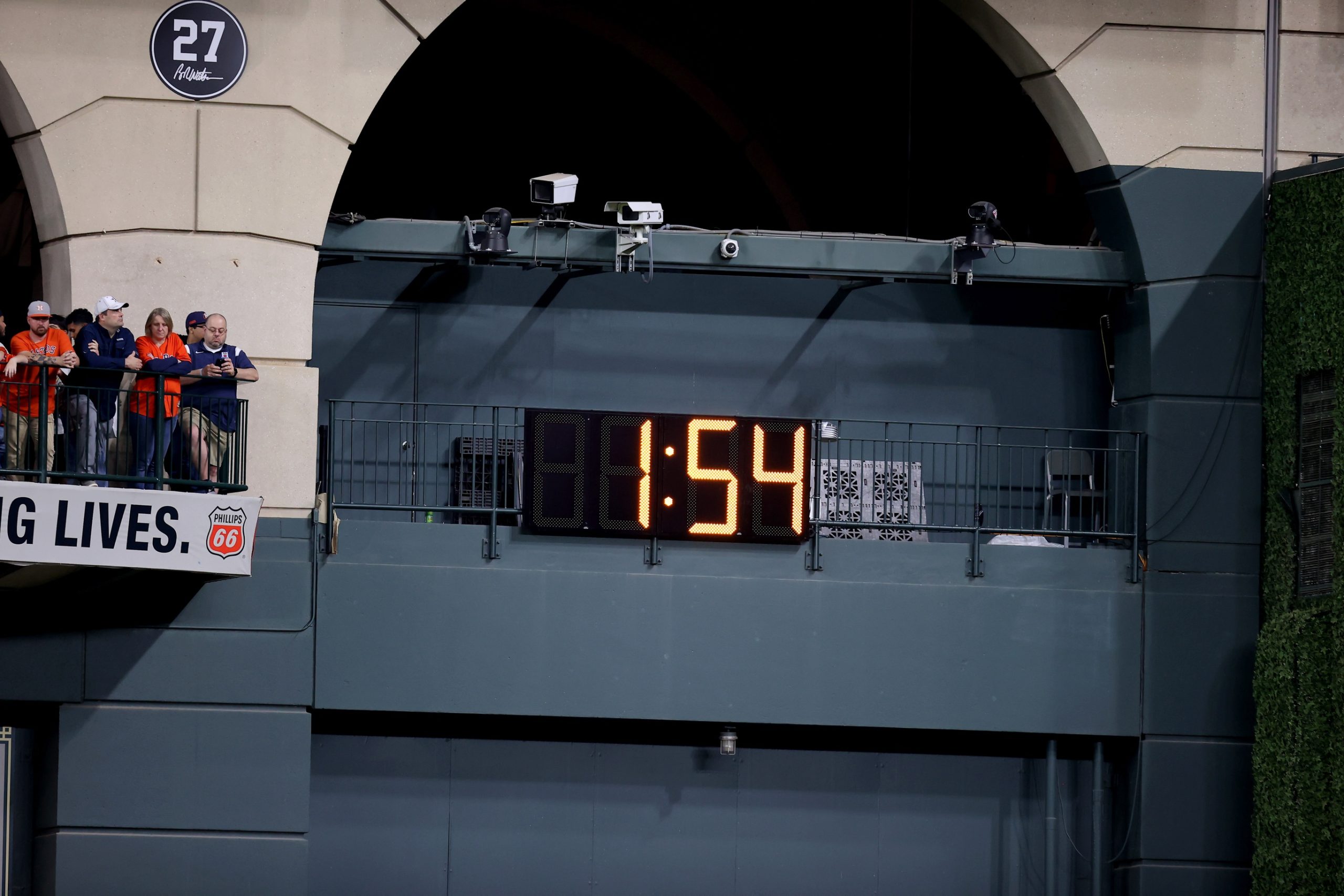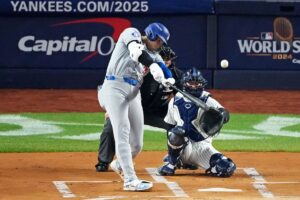Pitch Clock issues are still present throughout the league. Considering it takes about six seconds between the start of a pitcher’s delivery and when he receives his return throw, many players struggled initially, and some of them never quite recovered. Beyond the tallying of violations, there are plenty of reasons why it’s affecting some pitchers throughout the season. It’s something that needs to be assessed, including some of the new rule changes.
The Pitch Clock and Its Effects
The Winds of Change
Following recent experiments in the minor leagues, a pitch clock, limits on defensive shifts and bigger bases were introduced to MLB. The new rules aimed to increase the overall scoring, make the product on the field more entertaining, and most importantly, feel more accessible. The bases increased in size and the infield shift was banned, which led to a near 40% increase in stolen bases and batting splits averages going up league-wide.
League Batting Stats and Stolen Bases per Game 2022 vs 2023:
2022: .243 BA/ .312 OBP/ .395 SLG/ .706 OPS/ 511 SB
2023: .248 BA/ .320 OBP/ .413 SLG/ .733 OPS/ 711 SB
We are on pace to match the most stolen bases in MLB history.
Total stolen bases by year…
2021: 2,214
2022: 2,487
2023 (on July 3): 1,8101987 (record): 3,585 pic.twitter.com/ROOyMkB9J5
— Shawn Spradling (@Shawn_Spradling) July 4, 2023
In 2020, MLB changed its rules so that extra innings would begin with a runner on second base. The player who recorded the last out in the previous inning would be the “ghost runner” to begin the next inning. Baseball fans and players were divided over these modifications. However, most people didn’t oppose these changes, and some were even excited about them. After all, who doesn’t love action-packed, high-scoring games?
The most significant change became permanent this year and it’s by far their most controversial one.
The Pitch Clock
To create a quick pace of play, there’s a 30-second timer between batters. Between, pitches, there is a 15-second timer with the bases empty and a 20-second timer. To that end, the change worked beautifully. The games saw a 30-minute decrease in length, and the viewership numbers increased by ten percent compared to 2022.
the effect of mlb’s pitch clock & other game changes, graphed: pic.twitter.com/yjFz4Z1Umd
— ian bremmer (@ianbremmer) June 2, 2023
But the pitchers were not big fans of this new rule. And out of all the changes, this one affected them the most. Pitcher efficiency took a hit across the league, with some pitchers having awful starts. And most of them attributed their early struggles to the Pitch Clock.
League Pitching 2022 vs 2023:
2022: .3.96 ERA/ 1.266 WHIP
2023: .4.31 ERA/ 1.312 WHIP
The Ones Who Adapted
The timer affected the pitches around the league in a variety of ways. Most of them adapted immediately to the new rule, and only took a small hit to their stats. But the others couldn’t do that. Some pitchers had their routines rushed. The older players or the ones smaller in stature needed a little more time to rest their arms if the inning lasted more than 10-15 pitches. This applied to the out-of-shape ones too, as they struggled to keep up the pace. And these issues plagued the stars too.
Some of the aces in the game had brutal starts to the season. Either they have adjusted back to their game while others have not. For instance, Blake Snell had a 5.40 ERA and a 1.77 WHIP through his first nine starts. Others found it hard to maintain consistency. A pitcher like Corbin Burnes allowed ten runs in his first two starts that followed up with a 5.46 ERA after his next three starts. But what’s interesting is that the veteran starters took a step back as a group. The ERA of all starters 35 and older went up from 3.56 to 4.53.
And.. the Ones Who Haven’t
Nestor Cortes couldn’t buy a strong start with the New York Yankees prior to being injured. He was 5-2 with a 5.16 ERA through 11 starts. In his first start back last weekend, he gave up a solo home run to Jose Altuve, though it was the only hit he allowed over his four innings of work. He posted a season-high eight strikeouts to go with it. The Yankees certainly have to feel good about what they saw out of Cortes.
A conspiracy theory has brewed inside the Phillies clubhouse for weeks. The pitch clock, they said, was faster at Citizens Bank Park than anywhere else. Visiting players agreed. That can’t be. Right?
Now there’s data to support it. A modern baseball tale: https://t.co/FnYAqgYLTH pic.twitter.com/pfbri2FceO
— Matt Gelb (@MattGelb) June 9, 2023
Aaron Nola went from a top-five Cy Young vote-getter to a below-average pitcher. He’s struggled with power but he’s had some solid outings. Lance Lynn turned from an average starter to allowing the most home runs in the league. He coughed 17 earned runs in just 16 2/3 innings over his last three starts with the Chicago White Sox. Alek Manoah has probably had it the worst of them all. It’s been a year of regression for someone who was an All-Star and AL Cy Young finalist last year.
The Toronto Blue Jays optioned the right-hander to the Flordia Complex League. He owned a 6.36 ERA and opponents were hitting .289/.408/.485 against him. Since his return to the Blue Jaus, his work has been encouraging at times, but it hasn’t been reminiscent of his 2022 performance.
Some Concerns From One Particular Player
While the pitch clock has helped baseball reduce dead time during games, the players are voicing their concerns. Max Scherzer is a prime example of this, as he made his “love-hate” relationship with the pitch clock known a couple of times, as he is a fan of the concept.
“The umpires are frustrated, as we are, that the game is not normal, that we’re living and dying by the clock.”
Mets pitcher Max Scherzer frustrated with the pitch clock ⏰
(via @SNYtv)
pic.twitter.com/dsfBSbWSYj— Yahoo Sports (@YahooSports) June 1, 2023
Many others are frustrated with the strictness of the rules, as they prohibit spontaneous standing ovations, player routine and maybe even ruin the tense atmosphere of close games. Players have urged MLB to make adjustments to the clock for the Playoffs, as they feel it would enhance the watching experience.
The players reportedly want changes to the pitch clock for the playoffs. ?⌚️ pic.twitter.com/0Rd35MSSte
— theScore (@theScore) July 11, 2023
Final Thoughts
The pitch clock is here to stay, as its implementation has clear benefits for the league, the viewers and arguably for the sport itself. But we also have to consider the issues that have appeared throughout the year. Players have already voiced their displeasure with the rigidity of the system multiple times. All the pitchers have been affected by it in a variety of ways, and some far worse than others. So it is clear that MLB has to continue to polish the pitch clock, regardless of its early successes.
Photo Credit: © Erik Williams-USA TODAY Sports
Players Mentioned:
Blake Snell, Corbin Burnes, Nestor Cortes, Jose Altuve, Aaron Nola, Lance Lynn, Alek Manoah, Max Scherzer






